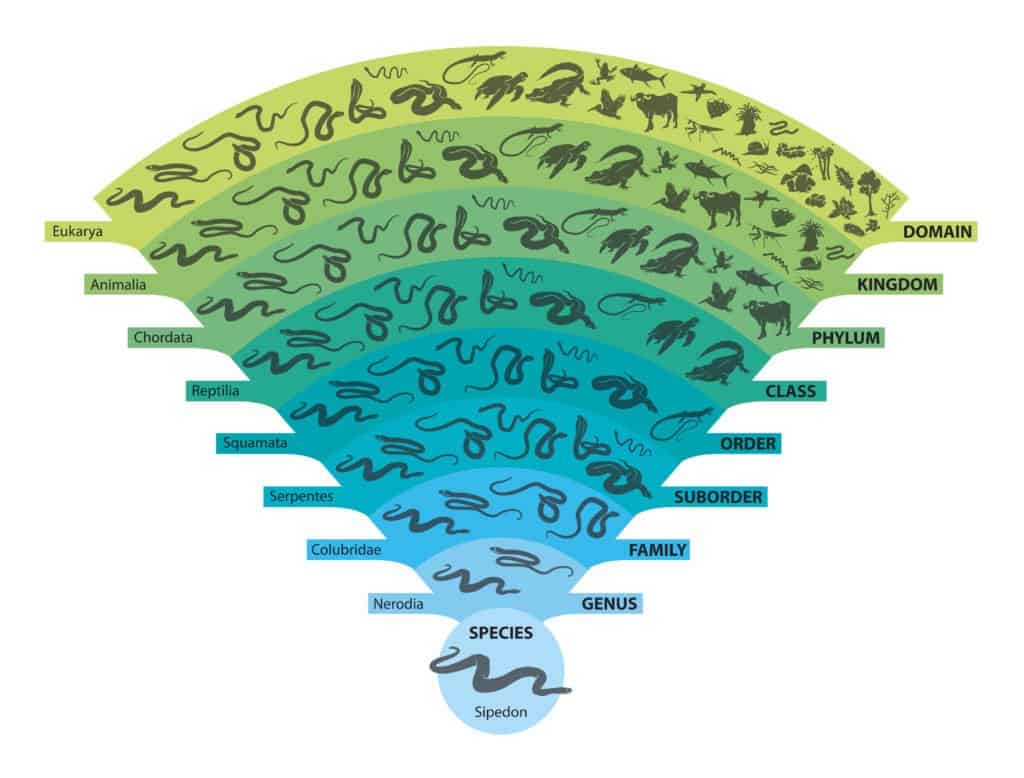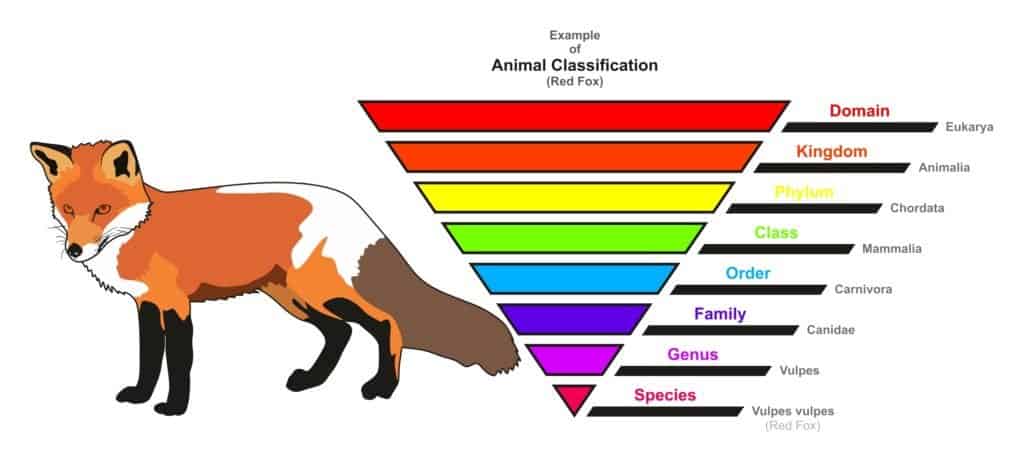What Do Groups Of Animals In A Phylum Share?
What is Beast Classification?
Animal kingdom nomenclature is an important system for understanding how all living organisms are related. Based on the Linnaeus method, species are arranged grouped based on shared characteristics.
This system of creature kingdom classification was developed by Swedish botanist Carolus (Carl) Linnaeus in the 1700'due south. The Linnaeus Method, likewise known as Linnaean Taxonomy, creates a hierarchy of groupings called taxa, as well as binomial classification that gives each animal species a two-word scientific proper noun. This method of giving scientific names to animals is typically rooted in Latin past combining the genus and species. For instance, humans are classified as homo sapiens while wolves are canis lupus.
The more features that a group of animals share, the more specific that animal classification group is. Every species is defined based on nine branching categories. The primary method of creature classification is:
- Domain
- Kingdom
- Phylum
- Class
- Order
- Suborder
- Brute Families
- Genus
- Species

EreborMountain/Shutterstock.com
Animate being Classification: The Six Different Animal Kingdoms
All living organisms can be placed in i of six different brute kingdom classifications. The characteristics of each creature kingdom are:
- Brute – A kingdom of complex multi-celled organisms that do not produce their own food. This kingdom contains all living and extinct animals. Examples include elephants, whales, and humans.
- Plants – Circuitous and multi cellular autotrophic organisms, meaning they produce their own food through photosynthesis. Examples include trees, flowers, and grass.
- Fungi – Multi-celled organisms that exercise non produce their ain food, unlike plants. Examples include molds, mushrooms, and yeast.
- Protista – Single celled organisms with more than complexity than either eubacteria or archaebacteria. Examples include algae and amoebas
- Eubacteria – Single celled organisms found in everything from yogurt to your intestines. This kingdom contains all bacteria in the world not considered archaebacteria.
- Archaebacteria – The oldest known living organisms. Single-celled and found in hostile and extremely hot areas similar thermal vents or hot springs
Animal Phylums Explained
After creature kingdom, creature species usually fall into ane of 7 different phylum, or phyla:
- Porifera – Marine animals more commonly known as sponges and institute in every ocean on earth.
- Cnidaria – By and large marine animals that include over xi,000 species. Examples include coral, jellyfish, and anemones
- Platyhelminthes – Typically parasitic flatworms. Lacking in whatever respiratory or circulatory systems, oxygen pass through their bodies instead in a process known every bit improvidence. Examples include tapeworms and flukes.
- Annelida – More complex than Platyhelminthes, these are segmented and symmetrical worms containing a nervous system, respiratory system, and sense organs. Examples include the common earthworm and leeches.
- Mollusca – The second largest phylum by species count, and the largest marine phylum. Invertebrates with soft unsegmented bodies. It is estimated most a quarter of marine life fall in this category. Examples include clams, mussels, and snails
- Arthropoda – Invertebrate animals with an exoskeleton and segmented bodies. Contains insects, crustaceans, and arachnids. This is the largest phylum by species count. Examples include scorpions, collywobbles, and shrimp
- Chordata – Vertebrates. Animals that develop a notochord, a cartilaginous skeletal rod that supports the trunk in embryo and can frequently get a spine. Most animals we are familiar with, including dogs, horses, birds, and humans fall in to this category.
Beast Classes
The phylum group is then divided into even smaller groups, known as animal classes. The Chordata phylum splits in to these 7 animal classes:
- Agnatha (jaw-less fish)
- Chrondrichtyes (cartilaginous fish)
- Osteichthyes (bony fish)
- Amphibia (amphibians)
- Reptilia (reptiles)
- Aves (birds)
- Mammalia (mammals)
Dissimilar Brute Orders
Each course is divided into small groups again, known every bit orders. There is no universally accepted breakdown for the class Mammalia. Some outline as many every bit 26 different orders for the class mammalia. Some of the virtually popular examples include:
- Artiodactyla (even-toed hoofed animals) – Examples include moose, camels, and giraffes
- Carnivora – Animals that specialize in mostly eating meat, but likewise contains some omnivores and herbivores. Characterized as having nonretractable claws and long snouts. Examples include bears.
- Rodentia (gnawing mammals) – Examples include beavers, mice, and squirrels
- Chiropptera (bats) – The merely mammals that can fly. Examples include free-tailed and vampire bats
- Cetacea (porpoises and whales) – Examples include killer whales, dolphins, and hump-backed whales
- Primates – Includes prehensile hands and feet, commonly with opposable thumbs. Examples include gorillas, chimpanzees, and humans.
Brute Families
In every guild, in that location are different animal families which all accept very similar features. The Carnivora gild breaks into brute families that include Felidae (Cats), Canidae (Dogs), Ursidae (Bears), and Mustelidae (Weasels).
Animal Genus Types
Every animal family is farther divided into small groups known as genus. Each genus contains animals that accept very similar features and are closely related. For instance, the Felidae (True cat) family contains genus including Felis (small Cats and domestic Cats), Panthera (Tigers, Leopards, Jaguars and Lions) and Puma (Panthers and Cougars).
Animal Species Names
Each private species within the genus is named after its individual features and characteristics. The names of animals are based in Latin and consist of 2 words. The first give-and-take in the proper noun of an fauna will be the genus, and the second proper noun indicates the specific species. This method of organizing scientific names of beast species was developed by Carl Linnaeus in the 1700's. As an example, a dolphin species name is Delphinus Delphis. A cherry-red fox is Vulpes vulpes. This animal classification chart of a cherry-red fob is an example of Linnaean Taxonomy

udaix/Shutterstock.com
Animal Classification Example ane – Red Fox
- (Vertebrate)
- Class: Mammalia (Mammal)
- Order: Carnivora (Carnivore)
- Family: Canidae (Dog)
- Genus: Vulpes
- Species: Vulpes vulpes (blood-red play a trick on)
Beast Classification Case 2 – Orang-utan
- Kingdom: Animalia (Fauna)
- Phylum: Chordata (Vertebrate)
- Class: Mammalia (Mammal)
- Order: Primates
- Family unit: Hominidae (Groovy Apes)
- Genus: Pongo
- Species: Pongo pygmaeus (Orang-Utan)
Source: https://a-z-animals.com/reference/animal-classification/
Posted by: sabalahavock.blogspot.com

0 Response to "What Do Groups Of Animals In A Phylum Share?"
Post a Comment